41 KiB
| categories | date | lastmod | thumbnail | usePageBundles | tags | title | |||||
|---|---|---|---|---|---|---|---|---|---|---|---|
| VMware | 2021-02-22T08:34:30Z | 2022-07-25 | 7_QI-Ti8g.png | true |
|
Integrating {php}IPAM with vRealize Automation 8 |
In a previous post, I described some of the steps I took to stand up a homelab including vRealize Automation (vRA) on an Intel NUC 9. One of my initial goals for that lab was to use it for developing and testing a way for vRA to leverage phpIPAM for static IP assignments. The homelab worked brilliantly for that purpose, and those extra internal networks were a big help when it came to testing. I was able to deploy and configure a new VM to host the phpIPAM instance, install the VMware vRealize Third-Party IPAM SDK on my Chromebook's Linux environment, develop and build the integration component, import it to my vRA environment, and verify that deployments got addressed accordingly.
The resulting integration is available on Github here. This was actually the second integration I'd worked on, having fumbled my way through a Solarwinds integration earlier last year. VMware's documentation on how to build these things is pretty good, but I struggled to find practical information on how a novice like me could actually go about developing the integration. So maybe these notes will be helpful to anyone seeking to write an integration for a different third-party IP Address Management solution.
If you'd just like to import a working phpIPAM integration into your environment without learning how the sausage is made, you can grab my latest compiled package here. You'll probably still want to look through Steps 0-2 to make sure your IPAM instance is set up similarly to mine.
Step 0: phpIPAM installation and base configuration
Before even worrying about the SDK, I needed to get a phpIPAM instance ready. I started with a small (1vCPU/1GB RAM/16GB HDD) VM attached to my "Home" network (192.168.1.0/24). I installed Ubuntu 20.04.1 LTS, and then used this guide to install phpIPAM.
Once phpIPAM was running and accessible via the web interface, I then used openssl to generate a self-signed certificate to be used for the SSL API connection:
sudo mkdir /etc/apache2/certificate # [tl! .cmd:2]
cd /etc/apache2/certificate/
sudo openssl req -new -newkey rsa:4096 -x509 -sha256 -days 365 -nodes -out apache-certificate.crt -keyout apache.key
I edited the apache config file to bind that new certificate on port 443, and to redirect requests on port 80 to port 443:
# torchlight! {"lineNumbers": true}
<VirtualHost *:80>
ServerName ipam.lab.bowdre.net
Redirect permanent / https://ipam.lab.bowdre.net
</VirtualHost>
<VirtualHost *:443>
DocumentRoot "/var/www/html/phpipam"
ServerName ipam.lab.bowdre.net
<Directory "/var/www/html/phpipam">
Options Indexes FollowSymLinks
AllowOverride All
Require all granted
</Directory>
ErrorLog "/var/log/apache2/phpipam-error_log"
CustomLog "/var/log/apache2/phpipam-access_log" combined
SSLEngine on
SSLCertificateFile /etc/apache2/certificate/apache-certificate.crt
SSLCertificateKeyFile /etc/apache2/certificate/apache.key
</VirtualHost>
After restarting apache, I verified that hitting http://ipam.lab.bowdre.net redirected me to https://ipam.lab.bowdre.net, and that the connection was secured with the shiny new certificate.
Remember how I've got a "Home" network as well as several internal networks which only exist inside the lab environment? I dropped the phpIPAM instance on the Home network to make it easy to connect to, but it doesn't know how to talk to the internal networks where vRA will actually be deploying the VMs. So I added a static route to let it know that traffic to 172.16.0.0/16 would have to go through the Vyos router at 192.168.1.100.
This is Ubuntu, so I edited /etc/netplan/99-netcfg-vmware.yaml to add the routes section at the bottom:
# torchlight! {"lineNumbers": true}
# /etc/netplan/99-netcfg-vmware.yaml
network:
version: 2
renderer: networkd
ethernets:
ens160:
dhcp4: no
dhcp6: no
addresses:
- 192.168.1.14/24
gateway4: 192.168.1.1
nameservers:
search:
- lab.bowdre.net
addresses:
- 192.168.1.5
routes: # [tl! focus:3]
- to: 172.16.0.0/16
via: 192.168.1.100
metric: 100
I then ran sudo netplan apply so the change would take immediate effect and confirmed the route was working by pinging the vCenter's interface on the 172.16.10.0/24 network:
sudo netplan apply # [tl! .cmd]
ip route # [tl! .cmd]
default via 192.168.1.1 dev ens160 proto static # [tl! .nocopy:3]
172.16.0.0/16 via 192.168.1.100 dev ens160 proto static metric 100
192.168.1.0/24 dev ens160 proto kernel scope link src 192.168.1.14
ping 172.16.10.12 # [tl! .cmd]
PING 172.16.10.12 (172.16.10.12) 56(84) bytes of data. # [tl! .nocopy:7]
64 bytes from 172.16.10.12: icmp_seq=1 ttl=64 time=0.282 ms
64 bytes from 172.16.10.12: icmp_seq=2 ttl=64 time=0.256 ms
64 bytes from 172.16.10.12: icmp_seq=3 ttl=64 time=0.241 ms
^C
--- 172.16.10.12 ping statistics ---
3 packets transmitted, 3 received, 0% packet loss, time 2043ms
rtt min/avg/max/mdev = 0.241/0.259/0.282/0.016 ms
Now would also be a good time to go ahead and enable cron jobs so that phpIPAM will automatically scan its defined subnets for changes in IP availability and device status. phpIPAM includes a pair of scripts in INSTALL_DIR/functions/scripts/: one for discovering new hosts, and the other for checking the status of previously discovered hosts. So I ran sudo crontab -e to edit root's crontab and pasted in these two lines to call both scripts every 15 minutes:
*/15 * * * * /usr/bin/php /var/www/html/phpipam/functions/scripts/discoveryCheck.php
*/15 * * * * /usr/bin/php /var/www/html/phpipam/functions/scripts/pingCheck.php
Step 1: Configuring phpIPAM API access
Okay, let's now move on to the phpIPAM web-based UI to continue the setup. After logging in at https://ipam.lab.bowdre.net/, I clicked on the red Administration menu at the right side and selected phpIPAM Settings. Under the Site Settings section, I enabled the Prettify links option, and under the Feature Settings section I toggled on the API component. I then hit Save at the bottom of the page to apply the changes.
Next, I went to the Users item on the left-hand menu to create a new user account which will be used by vRA. I named it vra, set a password for the account, and made it a member of the Operators group, but didn't grant any special module access.
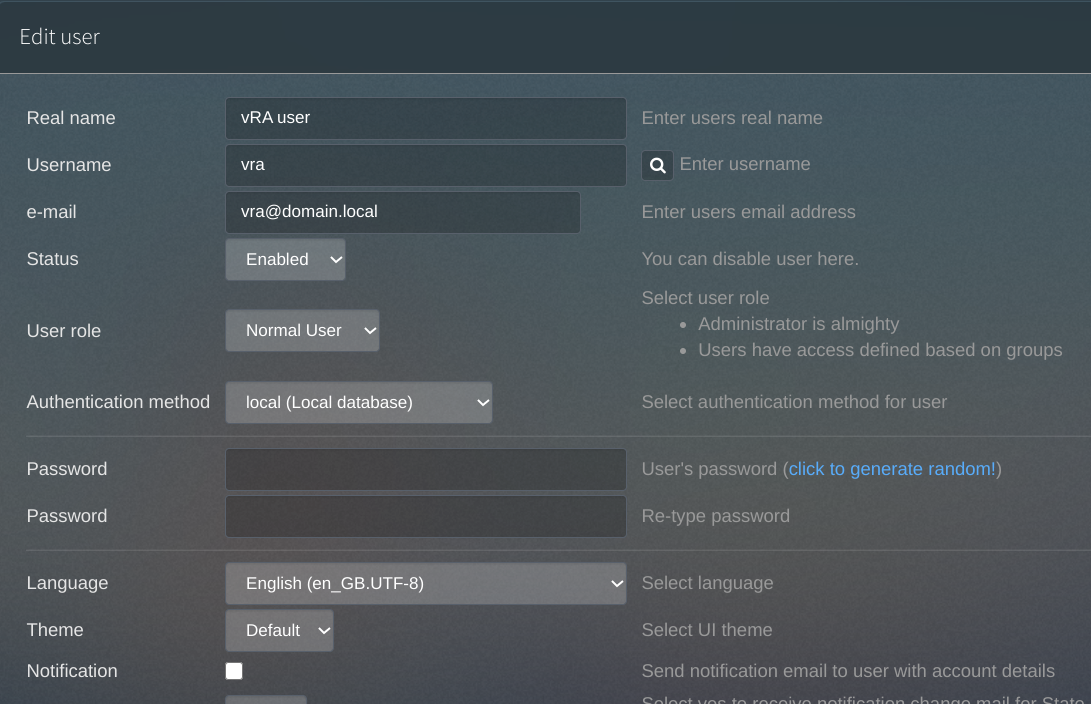
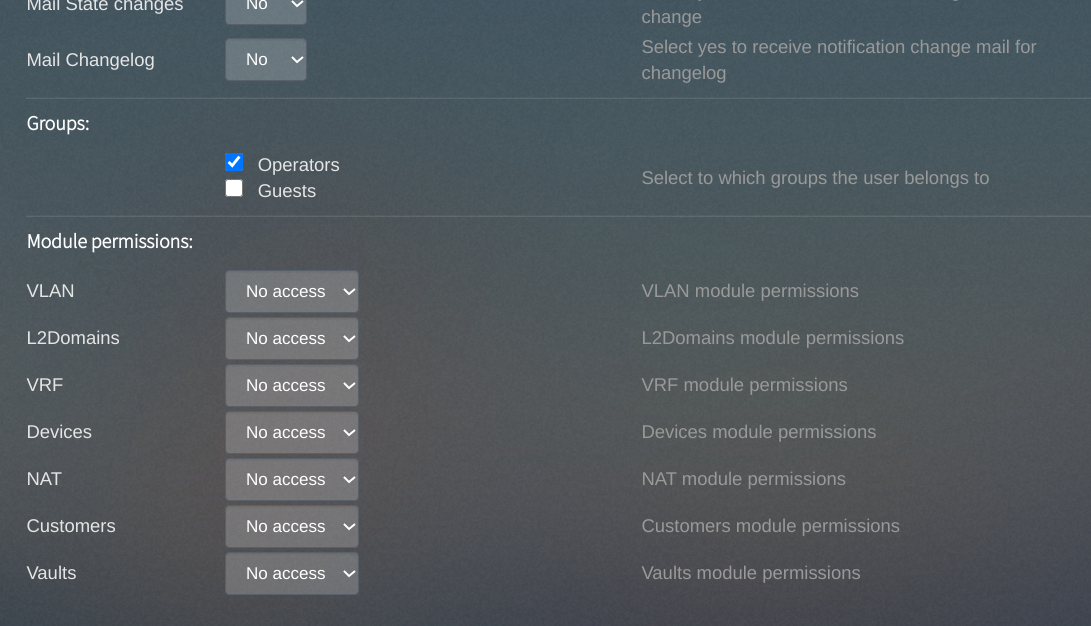
The last step in configuring API access is to create an API key. This is done by clicking the API item on that left side menu and then selecting Create API key. I gave it the app ID vra, granted Read/Write permissions, and set the App Security option to "SSL with User token".
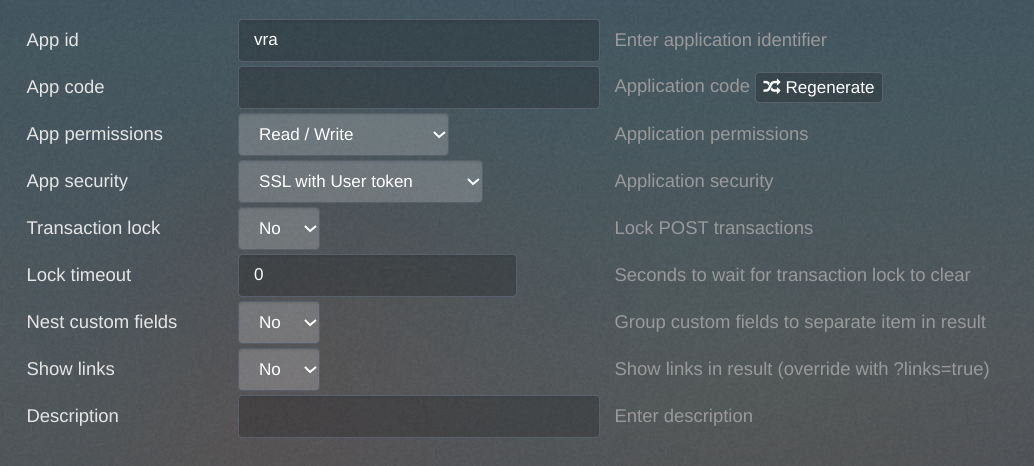
Once we get things going, our API calls will authenticate with the username and password to get a token and bind that to the app ID.
Step 2: Configuring phpIPAM subnets
Our fancy new IPAM solution is ready to go - except for the whole bit about managing IPs. We need to tell it about the network segments we'd like it to manage. phpIPAM uses "Sections" to group subnets together, so we start by creating a new Section at Administration > IP related management > Sections. I named my new section Lab, and pretty much left all the default options. Be sure that the Operators group has read/write access to this section and the subnets we're going to create inside it!

We should also go ahead and create a Nameserver set so that phpIPAM will be able to tell its clients (vRA) what server(s) to use for DNS. Do this at Administration > IP related management > Nameservers. I created a new entry called Lab and pointed it at my internal DNS server, 192.168.1.5.
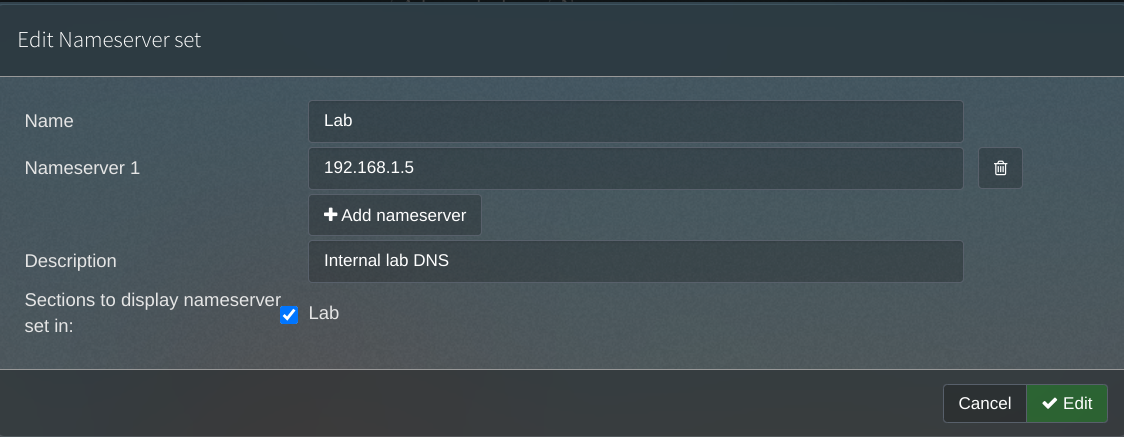
Okay, we're finally ready to start entering our subnets at Administration > IP related management > Subnets. For each one, I entered the Subnet in CIDR format, gave it a useful description, and associated it with my Lab section. I expanded the VLAN dropdown and used the Add new VLAN option to enter the corresponding VLAN information, and also selected the Nameserver I had just created.
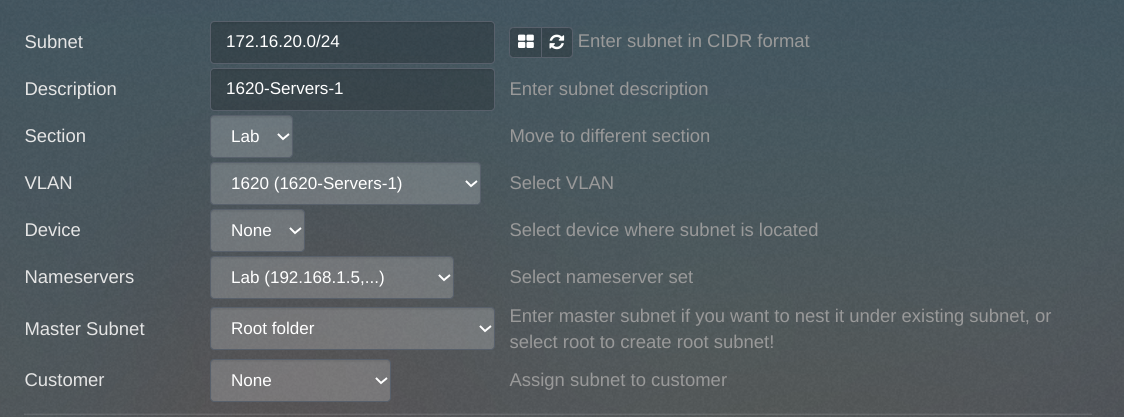 I also enabled the options
I also enabled the options Mark as pool, Check hosts status, Discover new hosts, and Resolve DNS names.
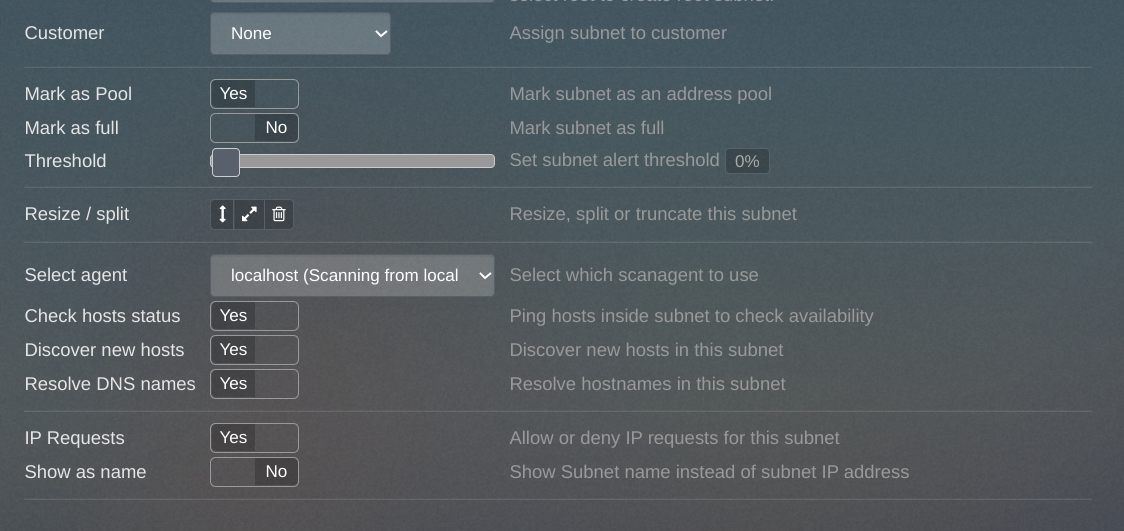
{{% notice note "Update" %}}
Since releasing this integration, I've learned that phpIPAM intends for the isPool field to identify networks where the entire range (including the subnet and broadcast addresses) are available for assignment. As a result, I no longer recommend using that field. Instead, consider creating a custom field for tagging networks for vRA availability.
{{% /notice %}}
I then used the Scan subnets for new hosts button to run a discovery scan against the new subnet.
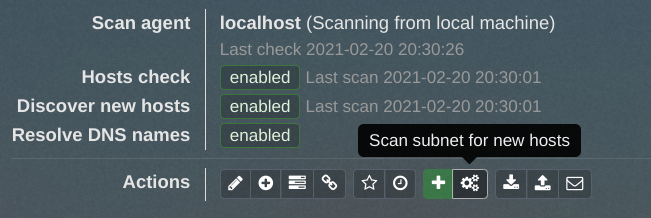
The scan only found a single host, 172.16.20.1, which is the subnet's gateway address hosted by the Vyos router. I used the pencil icon to edit the IP and mark it as the gateway:
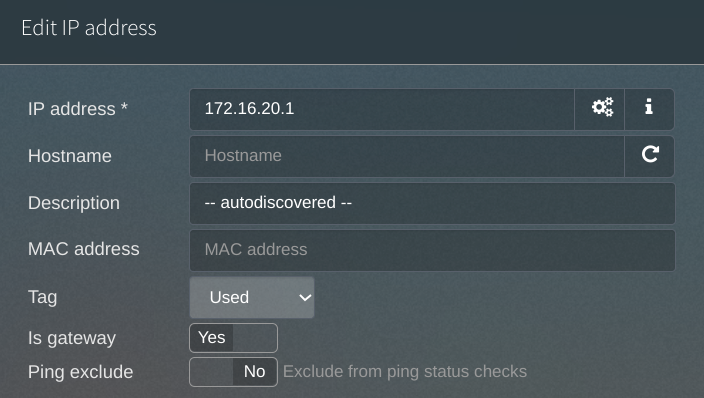
phpIPAM now knows the network address, mask, gateway, VLAN, and DNS configuration for this subnet - all things that will be useful for clients seeking an address. I then repeated these steps for the remaining subnets.
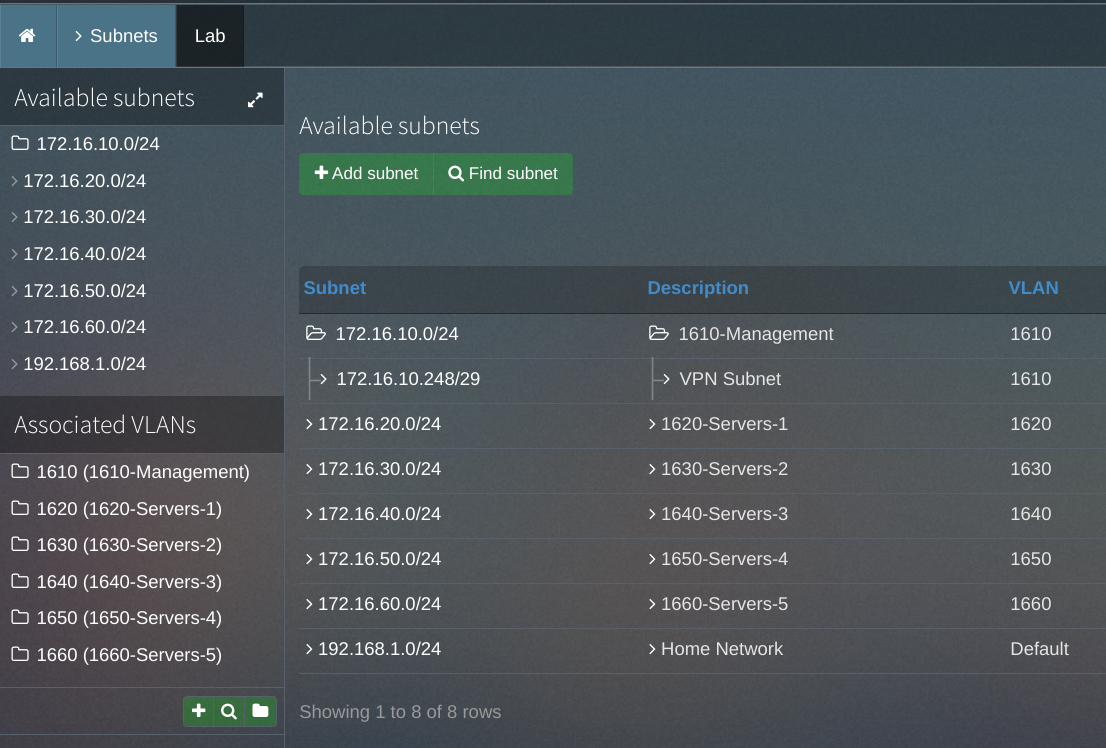
Now for the real fun!
Step 3: Testing the API
Before moving on to developing the integration, it would be good to first get a little bit familiar with the phpIPAM API - and, in the process, validate that everything is set up correctly. First I read through the API documentation and some example API calls to get a feel for it. I then started by firing up a python3 interpreter and defining a few variables as well as importing the requests module for interacting with the REST API:
>>> username = 'vra'
>>> password = 'passw0rd'
>>> hostname = 'ipam.lab.bowdre.net'
>>> apiAppId = 'vra'
>>> uri = f'https://{hostname}/api/{apiAppId}/'
>>> auth = (username, password)
>>> import requests
Based on reading the API docs, I'll need to use the username and password for initial authentication which will provide me with a token to use for subsequent calls. So I'll construct the URI used for auth, submit a POST to authenticate, verify that the authentication was successful (status_code == 200), and take a look at the response to confirm that I got a token. (For testing, I'm calling requests with verify=False; we'll be able to use certificate verification when these calls are made from vRA.)
>>> auth_uri = f'{uri}/user/'
>>> req = requests.post(auth_uri, auth=auth, verify=False)
/usr/lib/python3/dist-packages/urllib3/connectionpool.py:849: InsecureRequestWarning: Unverified HTTPS request is being made. Adding certificate verification is strongly advised. See: https://urllib3.readthedocs.io/en/latest/advanced-usage.html#ssl-warnings
InsecureRequestWarning)
>>> req.status_code
200
>>> req.json()
{'code': 200, 'success': True, 'data': {'token': 'Q66bVm8FTpnmBEJYhl5I4ITp', 'expires': '2021-02-22 00:52:35'}, 'time': 0.01}
Sweet! There's our token! Let's save it to token to make it easier to work with:
>>> token = {"token": req.json()['data']['token']}
>>> token
{'token': 'Q66bVm8FTpnmBEJYhl5I4ITp'}
Let's see if we can use our new token against the subnets controller to get a list of subnets known to phpIPAM:
subnet_uri = f'{uri}/subnets/'
>>> subnets = requests.get(subnet_uri, headers=token, verify=False)
/usr/lib/python3/dist-packages/urllib3/connectionpool.py:849: InsecureRequestWarning: Unverified HTTPS request is being made. Adding certificate verification is strongly advised. See: https://urllib3.readthedocs.io/en/latest/advanced-usage.html#ssl-warnings
InsecureRequestWarning)
>>> req.status_code
200
>>> subnets.json()
{'code': 200, 'success': True, 'data': [{'id': '7', 'subnet': '192.168.1.0', 'mask': '24', 'sectionId': '1', 'description': 'Home Network', 'linked_subnet': None, 'firewallAddressObject': None, 'vrfId': None, 'masterSubnetId': '0', 'allowRequests': '0', 'vlanId': None, 'showName': '0', 'device': None, 'permissions': [{'group_id': 3, 'permission': '1', 'name': 'Guests', 'desc': 'default Guest group (viewers)', 'members': False}, {'group_id': 2, 'permission': '2', 'name': 'Operators', 'desc': 'default Operator group', 'members': [{'username': 'vra'}]}], 'pingSubnet': '1', 'discoverSubnet': '1', 'resolveDNS': '1', 'DNSrecursive': '0', 'DNSrecords': '0', 'nameserverId': '1', 'scanAgent': '1', 'customer_id': None, 'isFolder': '0', 'isFull': '0', 'isPool': '0', 'tag': '2', 'threshold': '0', 'location': [], 'editDate': '2021-02-21 22:45:01', 'lastScan': '2021-02-21 22:45:01', 'lastDiscovery': '2021-02-21 22:45:01', 'nameservers': {'id': '1', 'name': 'Google NS', 'namesrv1': '8.8.8.8;8.8.4.4', 'description': 'Google public nameservers', 'permissions': '1;2', 'editDate': None}},...
Nice! Let's make it a bit more friendly:
>>> subnets = subnets.json()['data']
>>> for subnet in subnets:
... print("Found subnet: " + subnet['description'])
...
Found subnet: Home Network
Found subnet: 1610-Management
Found subnet: 1620-Servers-1
Found subnet: 1630-Servers-2
Found subnet: VPN Subnet
Found subnet: 1640-Servers-3
Found subnet: 1650-Servers-4
Found subnet: 1660-Servers-5
We're in business!
Now that I know how to talk to phpIPAM via its RESP API, it's time to figure out how to get vRA to speak that language.
Step 4: Getting started with the vRA Third-Party IPAM SDK
I downloaded the SDK from here. It's got a pretty good README which describes the requirements (Java 8+, Maven 3, Python3, Docker, internet access) as well as how to build the package. I also consulted this white paper which describes the inputs provided by vRA and the outputs expected from the IPAM integration.
The README tells you to extract the .zip and make a simple modification to the pom.xml file to "brand" the integration:
# torchlight! {"lineNumbers": true}
<properties>
<provider.name>phpIPAM</provider.name> <!-- [tl! focus:2] -->
<provider.description>phpIPAM integration for vRA</provider.description>
<provider.version>1.0.3</provider.version>
<provider.supportsAddressSpaces>false</provider.supportsAddressSpaces>
<provider.supportsUpdateRecord>true</provider.supportsUpdateRecord>
<provider.supportsOnDemandNetworks>false</provider.supportsOnDemandNetworks>
<user.id>1000</user.id>
</properties>
You can then kick off the build with mvn package -PcollectDependencies -Duser.id=${UID}, which will (eventually) spit out ./target/phpIPAM.zip. You can then import the package to vRA and test it against the httpbin.org hostname to validate that the build process works correctly.
You'll notice that the form includes fields for Username, Password, and Hostname; we'll also need to specify the API app ID. This can be done by editing ./src/main/resources/endpoint-schema.json. I added an apiAppId field:
// torchlight! {"lineNumbers":true}
{
"layout":{
"pages":[
{
"id":"Sample IPAM",
"title":"Sample IPAM endpoint",
"sections":[
{
"id":"section_1",
"fields":[
{
"id":"apiAppId", // [tl! focus]
"display":"textField"
},
{
"id":"privateKeyId",
"display":"textField"
},
{
"id":"privateKey",
"display":"passwordField"
},
{
"id":"hostName",
"display":"textField"
}
]
}
]
}
]
},
"schema":{
"apiAppId":{
"type":{
"dataType":"string"
},
"label":"API App ID", // [tl! focus]
"constraints":{
"required":true
}
},
"privateKeyId":{
"type":{
"dataType":"string"
},
"label":"Username",
"constraints":{
"required":true
}
},
"privateKey":{
"label":"Password",
"type":{
"dataType":"secureString"
},
"constraints":{
"required":true
}
},
"hostName":{
"type":{
"dataType":"string"
},
"label":"Hostname",
"constraints":{
"required":true
}
}
},
"options":{
}
}
{{% notice note "Update" %}} Check out the source on GitHub to see how I adjusted the schema to support custom field input. {{% /notice %}}
We've now got the framework in place so let's move on to the first operation we'll need to write. Each operation has its own subfolder under ./src/main/python/, and each contains (among other things) a requirements.txt file which will tell Maven what modules need to be imported and a source.py file which is where the magic happens.
Step 5: 'Validate Endpoint' action
We already basically wrote this earlier with the manual tests against the phpIPAM API. This operation basically just needs to receive the endpoint details and credentials from vRA, test the connection against the API, and let vRA know whether or not it was able to authenticate successfully. So let's open ./src/main/python/validate_endpoint/source.py and get to work.
It's always a good idea to start by reviewing the example payload section so that we'll know what data we have to work with:
'''
Example payload:
"inputs": {
"authCredentialsLink": "/core/auth/credentials/13c9cbade08950755898c4b89c4a0",
"endpointProperties": {
"hostName": "sampleipam.sof-mbu.eng.vmware.com"
}
}
'''
The do_validate_endpoint function has a handy comment letting us know that's where we'll drop in our code:
# torchlight! {"lineNumbers": true}
def do_validate_endpoint(self, auth_credentials, cert):
# Your implemention goes here
username = auth_credentials["privateKeyId"]
password = auth_credentials["privateKey"]
try:
response = requests.get("https://" + self.inputs["endpointProperties"]["hostName"], verify=cert, auth=(username, password))
The example code gives us a nice start at how we'll get our inputs from vRA. So let's expand that a bit:
# torchlight! {"lineNumbers": true}
def do_validate_endpoint(self, auth_credentials, cert):
# Build variables
username = auth_credentials["privateKeyId"]
password = auth_credentials["privateKey"]
hostname = self.inputs["endpointProperties"]["hostName"]
apiAppId = self.inputs["endpointProperties"]["apiAppId"]
As before, we'll construct the "base" URI by inserting the hostname and apiAppId, and we'll combine the username and password into our auth variable:
# torchlight! {"lineNumbers": true}
uri = f'https://{hostname}/api/{apiAppId}/
auth = (username, password)
I realized that I'd be needing to do the same authentication steps for each one of these operations, so I created a new auth_session() function to do the heavy lifting. Other operations will also need to return the authorization token but for this run we really just need to know whether the authentication was successful, which we can do by checking req.status_code.
# torchlight! {"lineNumbers": true}
def auth_session(uri, auth, cert):
auth_uri = f'{uri}/user/'
req = requests.post(auth_uri, auth=auth, verify=cert)
return req
And we'll call that function from do_validate_endpoint():
# torchlight! {"lineNumbers": true}
# Test auth connection
try:
response = auth_session(uri, auth, cert)
if response.status_code == 200:
return {
"message": "Validated successfully",
"statusCode": "200"
}
You can view the full code here.
After completing each operation, run mvn package -PcollectDependencies -Duser.id=${UID} to build again, and then import the package to vRA again. This time, you'll see the new "API App ID" field on the form:
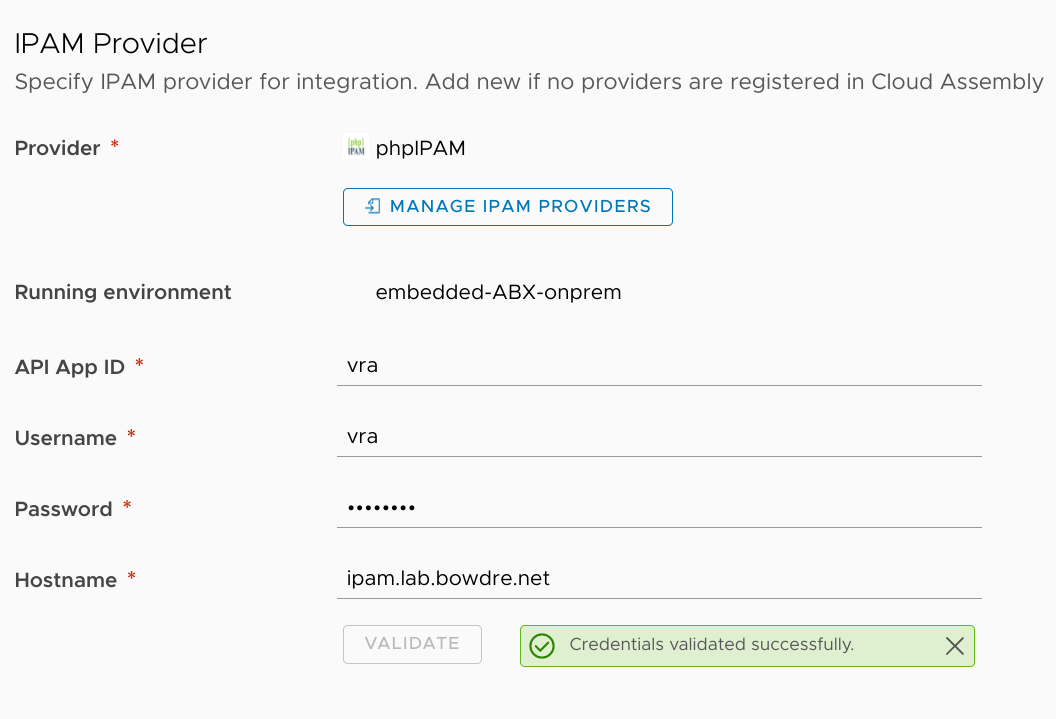
Confirm that everything worked correctly by hopping over to the Extensibility tab, selecting Action Runs on the left, and changing the User Runs filter to say Integration Runs.
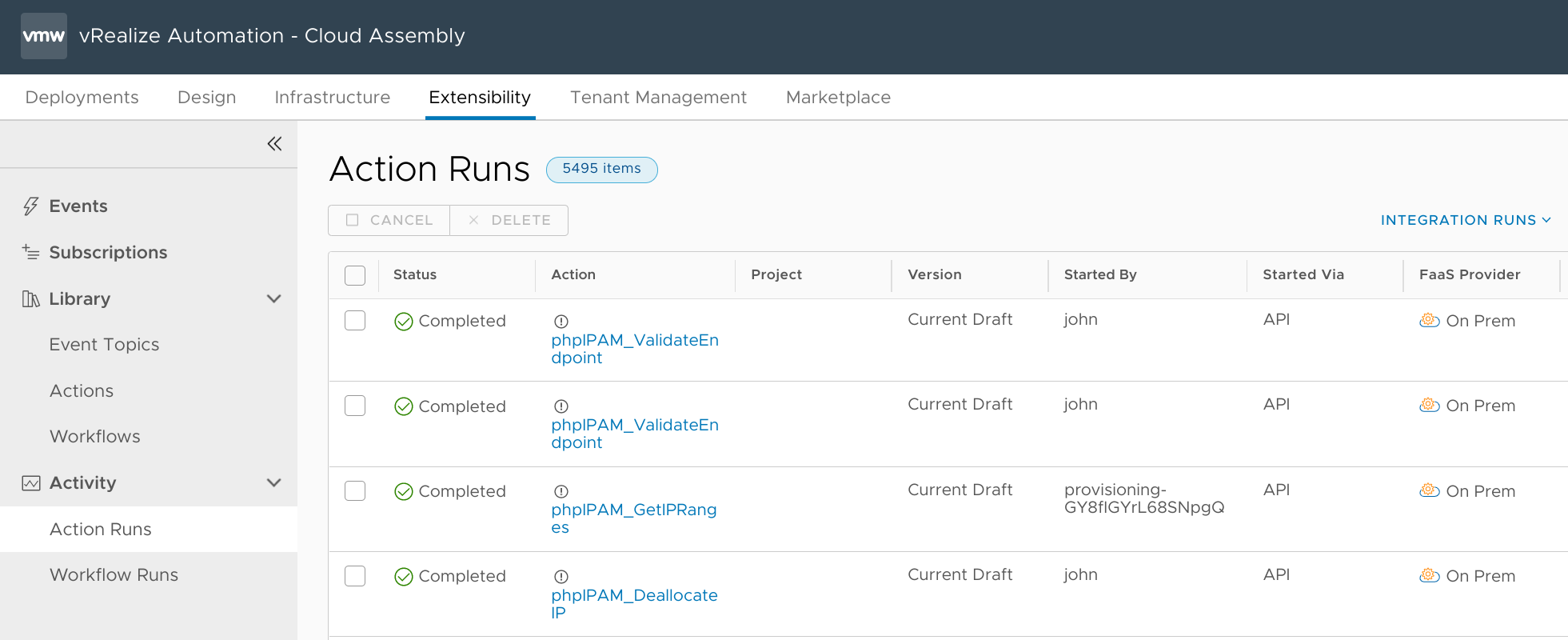 Select the newest
Select the newest phpIPAM_ValidateEndpoint action and make sure it has a happy green Completed status. You can also review the Inputs to make sure they look like what you expected:
// torchlight! {"lineNumbers": true}
{
"__metadata": {
"headers": {
"tokenId": "c/FqqI+i9WF47JkCxBsy8uoQxjyq+nlH0exxLYDRzTk="
},
"sourceType": "ipam"
},
"endpointProperties": {
"dcId": "onprem",
"apiAppId": "vra",
"hostName": "ipam.lab.bowdre.net",
"properties": "[{\"prop_key\":\"phpIPAM.IPAM.apiAppId\",\"prop_value\":\"vra\"}]",
"providerId": "301de00f-d267-4be2-8065-fabf48162dc1",
And we can see that the Outputs reflect our successful result:
{
"message": "Validated successfully",
"statusCode": "200"
}
That's one operation in the bank!
Step 6: 'Get IP Ranges' action
So vRA can authenticate against phpIPAM; next, let's actually query to get a list of available IP ranges. This happens in ./src/main/python/get_ip_ranges/source.py. We'll start by pulling over our auth_session() function and flesh it out a bit more to return the authorization token:
# torchlight! {"lineNumbers": true}
def auth_session(uri, auth, cert):
auth_uri = f'{uri}/user/'
req = requests.post(auth_uri, auth=auth, verify=cert)
if req.status_code != 200:
raise requests.exceptions.RequestException('Authentication Failure!')
token = {"token": req.json()['data']['token']}
return token
We'll then modify do_get_ip_ranges() with our needed variables, and then call auth_session() to get the necessary token:
# torchlight! {"lineNumbers": true}
def do_get_ip_ranges(self, auth_credentials, cert):
# Build variables
username = auth_credentials["privateKeyId"]
password = auth_credentials["privateKey"]
hostname = self.inputs["endpoint"]["endpointProperties"]["hostName"]
apiAppId = self.inputs["endpoint"]["endpointProperties"]["apiAppId"]
uri = f'https://{hostname}/api/{apiAppId}/'
auth = (username, password)
# Auth to API
token = auth_session(uri, auth, cert)
We can then query for the list of subnets, just like we did earlier:
# torchlight! {"lineNumbers": true}
# Request list of subnets
subnet_uri = f'{uri}/subnets/'
ipRanges = []
subnets = requests.get(f'{subnet_uri}?filter_by=isPool&filter_value=1', headers=token, verify=cert)
subnets = subnets.json()['data']
I decided to add the extra filter_by=isPool&filter_value=1 argument to the query so that it will only return subnets marked as a pool in phpIPAM. This way I can use phpIPAM for monitoring address usage on a much larger set of subnets while only presenting a handful of those to vRA.
{{% notice note "Update" %}} I now filter for networks identified by the designated custom field like so:
# torchlight! {"lineNumbers": true}
# Request list of subnets
subnet_uri = f'{uri}/subnets/'
if enableFilter == "true":
queryFilter = f'filter_by={filterField}&filter_value={filterValue}'
logging.info(f"Searching for subnets matching filter: {queryFilter}")
else:
queryFilter = ''
logging.info(f"Searching for all known subnets")
ipRanges = []
subnets = requests.get(f'{subnet_uri}?{queryFilter}', headers=token, verify=cert)
subnets = subnets.json()['data']
{{% /notice %}}
Now is a good time to consult that white paper to confirm what fields I'll need to return to vRA. That lets me know that I'll need to return ipRanges which is a list of IpRange objects. IpRange requires id, name, startIPAddress, endIPAddress, ipVersion, and subnetPrefixLength properties. It can also accept description, gatewayAddress, and dnsServerAddresses properties, among others. Some of these properties are returned directly by the phpIPAM API, but others will need to be computed on the fly.
For instance, these are pretty direct matches:
# torchlight! {"lineNumbers": true}
ipRange['id'] = str(subnet['id'])
ipRange['description'] = str(subnet['description'])
ipRange['subnetPrefixLength'] = str(subnet['mask'])
phpIPAM doesn't return a name field but I can construct one that will look like 172.16.20.0/24:
ipRange['name'] = f"{str(subnet['subnet'])}/{str(subnet['mask'])}"
Working with IP addresses in Python can be greatly simplified by use of the ipaddress module, so I added an import ipaddress statement near the top of the file. I also added it to requirements.txt to make sure it gets picked up by the Maven build. I can then use that to figure out the IP version as well as computing reasonable start and end IP addresses:
# torchlight! {"lineNumbers": true}
network = ipaddress.ip_network(str(subnet['subnet']) + '/' + str(subnet['mask']))
ipRange['ipVersion'] = 'IPv' + str(network.version)
ipRange['startIPAddress'] = str(network[1])
ipRange['endIPAddress'] = str(network[-2])
I'd like to try to get the DNS servers from phpIPAM if they're defined, but I also don't want the whole thing to puke if a subnet doesn't have that defined. phpIPAM returns the DNS servers as a semicolon-delineated string; I need them to look like a Python list:
# torchlight! {"lineNumbers": true}
try:
ipRange['dnsServerAddresses'] = [server.strip() for server in str(subnet['nameservers']['namesrv1']).split(';')]
except:
ipRange['dnsServerAddresses'] = []
I can also nest another API request to find which address is marked as the gateway for a given subnet:
# torchlight! {"lineNumbers": true}
gw_req = requests.get(f"{subnet_uri}/{subnet['id']}/addresses/?filter_by=is_gateway&filter_value=1", headers=token, verify=cert)
if gw_req.status_code == 200:
gateway = gw_req.json()['data'][0]['ip']
ipRange['gatewayAddress'] = gateway
And then I merge each of these ipRange objects into the ipRanges list which will be returned to vRA:
# torchlight! {"lineNumbers": true}
ipRanges.append(ipRange)
After rearranging a bit and tossing in some logging, here's what I've got:
# torchlight! {"lineNumbers": true}
for subnet in subnets:
ipRange = {}
ipRange['id'] = str(subnet['id'])
ipRange['name'] = f"{str(subnet['subnet'])}/{str(subnet['mask'])}"
ipRange['description'] = str(subnet['description'])
logging.info(f"Found subnet: {ipRange['name']} - {ipRange['description']}.")
network = ipaddress.ip_network(str(subnet['subnet']) + '/' + str(subnet['mask']))
ipRange['ipVersion'] = 'IPv' + str(network.version)
ipRange['startIPAddress'] = str(network[1])
ipRange['endIPAddress'] = str(network[-2])
ipRange['subnetPrefixLength'] = str(subnet['mask'])
# return empty set if no nameservers are defined in IPAM
try:
ipRange['dnsServerAddresses'] = [server.strip() for server in str(subnet['nameservers']['namesrv1']).split(';')]
except:
ipRange['dnsServerAddresses'] = []
# try to get the address marked as the gateway in IPAM
gw_req = requests.get(f"{subnet_uri}/{subnet['id']}/addresses/?filter_by=is_gateway&filter_value=1", headers=token, verify=cert)
if gw_req.status_code == 200:
gateway = gw_req.json()['data'][0]['ip']
ipRange['gatewayAddress'] = gateway
logging.debug(ipRange)
ipRanges.append(ipRange)
# Return results to vRA
result = {
"ipRanges" : ipRanges
}
return result
The full code can be found here. You may notice that I removed all the bits which were in the VMware-provided skeleton about paginating the results. I honestly wasn't entirely sure how to implement that, and I also figured that since I'm already limiting the results by the is_pool filter I shouldn't have a problem with the IPAM server returning an overwhelming number of IP ranges. That could be an area for future improvement though.
In any case, it's time to once again use mvn package -PcollectDependencies -Duser.id=${UID} to fire off the build, and then import phpIPAM.zip into vRA.
vRA runs the phpIPAM_GetIPRanges action about every ten minutes so keep checking back on the Extensibility > Action Runs view until it shows up. You can then select the action and review the Log to see which IP ranges got picked up:
[2021-02-21 23:14:04,026] [INFO] - Querying for auth credentials
[2021-02-21 23:14:04,051] [INFO] - Credentials obtained successfully!
[2021-02-21 23:14:04,089] [INFO] - Found subnet: 172.16.10.0/24 - 1610-Management.
[2021-02-21 23:14:04,101] [INFO] - Found subnet: 172.16.20.0/24 - 1620-Servers-1.
[2021-02-21 23:14:04,114] [INFO] - Found subnet: 172.16.30.0/24 - 1630-Servers-2.
[2021-02-21 23:14:04,126] [INFO] - Found subnet: 172.16.40.0/24 - 1640-Servers-3.
[2021-02-21 23:14:04,138] [INFO] - Found subnet: 172.16.50.0/24 - 1650-Servers-4.
[2021-02-21 23:14:04,149] [INFO] - Found subnet: 172.16.60.0/24 - 1660-Servers-5.
Note that it did not pick up my "Home Network" range since it wasn't set to be a pool.
We can also navigate to Infrastructure > Networks > IP Ranges to view them in all their glory:
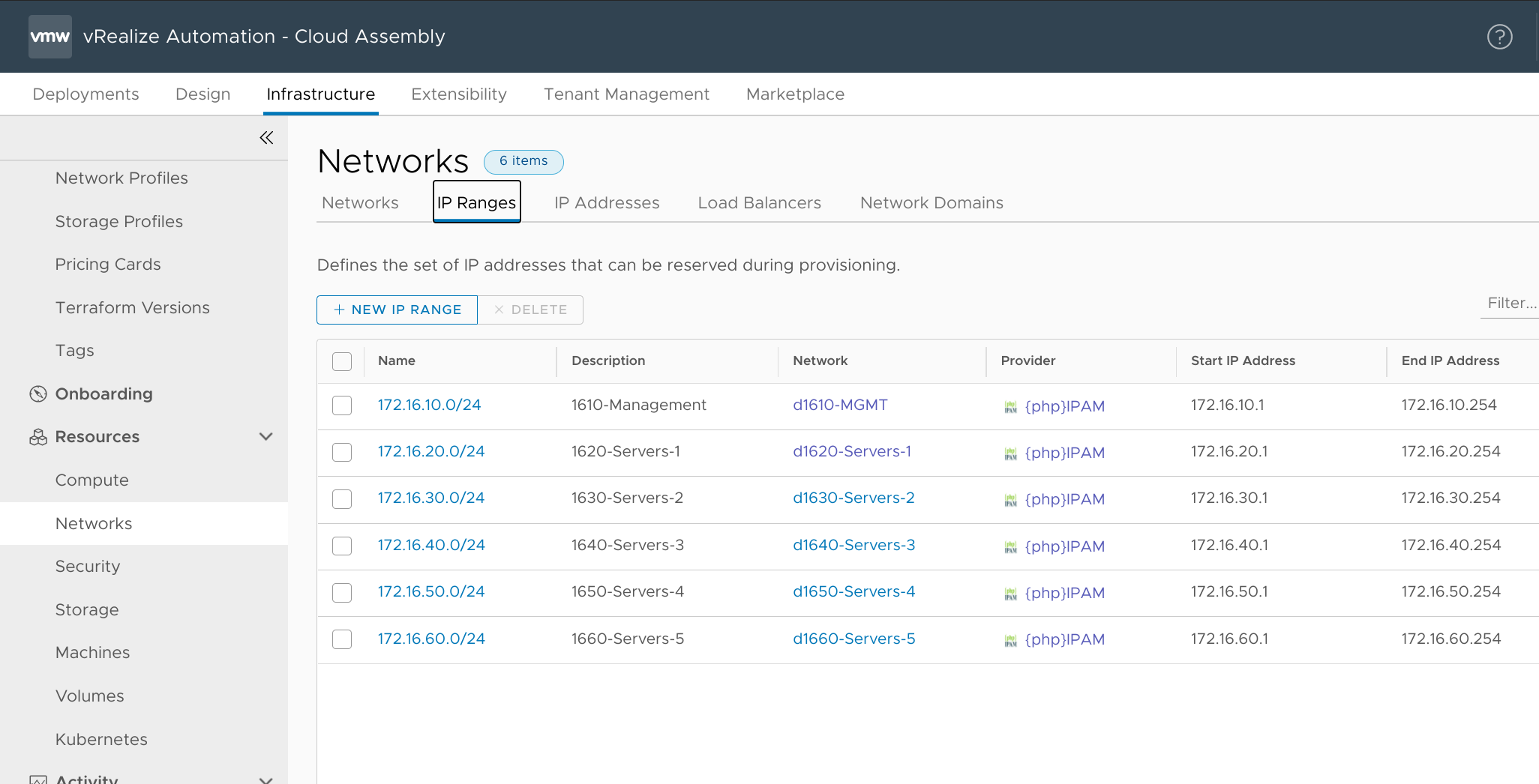
You can then follow these instructions to associate the external IP ranges with networks available for vRA deployments.
Next, we need to figure out how to allocate an IP.
Step 7: 'Allocate IP' action
I think we've got a rhythm going now. So we'll dive in to ./src/main/python/allocate_ip/source.py, create our auth_session() function, and add our variables to the do_allocate_ip() function. I also created a new bundle object to hold the uri, token, and cert items so that I don't have to keep typing those over and over and over.
# torchlight! {"lineNumbers": true}
def auth_session(uri, auth, cert):
auth_uri = f'{uri}/user/'
req = requests.post(auth_uri, auth=auth, verify=cert)
if req.status_code != 200:
raise requests.exceptions.RequestException('Authentication Failure!')
token = {"token": req.json()['data']['token']}
return token
def do_allocate_ip(self, auth_credentials, cert):
# Build variables
username = auth_credentials["privateKeyId"]
password = auth_credentials["privateKey"]
hostname = self.inputs["endpoint"]["endpointProperties"]["hostName"]
apiAppId = self.inputs["endpoint"]["endpointProperties"]["apiAppId"]
uri = f'https://{hostname}/api/{apiAppId}/'
auth = (username, password)
# Auth to API
token = auth_session(uri, auth, cert)
bundle = {
'uri': uri,
'token': token,
'cert': cert
}
I left the remainder of do_allocate_ip() intact but modified its calls to other functions so that my new bundle would be included:
# torchlight! {"lineNumbers": true}
allocation_result = []
try:
resource = self.inputs["resourceInfo"]
for allocation in self.inputs["ipAllocations"]:
allocation_result.append(allocate(resource, allocation, self.context, self.inputs["endpoint"], bundle))
except Exception as e:
try:
rollback(allocation_result, bundle)
except Exception as rollback_e:
logging.error(f"Error during rollback of allocation result {str(allocation_result)}")
logging.error(rollback_e)
raise e
I also added bundle to the allocate() function:
# torchlight! {"lineNumbers": true}
def allocate(resource, allocation, context, endpoint, bundle):
last_error = None
for range_id in allocation["ipRangeIds"]:
logging.info(f"Allocating from range {range_id}")
try:
return allocate_in_range(range_id, resource, allocation, context, endpoint, bundle)
except Exception as e:
last_error = e
logging.error(f"Failed to allocate from range {range_id}: {str(e)}")
logging.error("No more ranges. Raising last error")
raise last_error
The heavy lifting is actually handled in allocate_in_range(). Right now, my implementation only supports doing a single allocation so I added an escape in case someone asks to do something crazy like allocate 2 IPs. I then set up my variables:
# torchlight! {"lineNumbers": true}
def allocate_in_range(range_id, resource, allocation, context, endpoint, bundle):
if int(allocation['size']) ==1:
vmName = resource['name']
owner = resource['owner']
uri = bundle['uri']
token = bundle['token']
cert = bundle['cert']
else:
# TODO: implement allocation of continuous block of IPs
pass
raise Exception("Not implemented")
I construct a payload that will be passed to the phpIPAM API when an IP gets allocated to a VM:
payload = {
'hostname': vmName,
'description': f'Reserved by vRA for {owner} at {datetime.now()}'
}
That timestamp will be handy when reviewing the reservations from the phpIPAM side of things. Be sure to add an appropriate import datetime statement at the top of this file, and include datetime in requirements.txt.
So now we'll construct the URI and post the allocation request to phpIPAM. We tell it which range_id to use and it will return the first available IP.
# torchlight! {"lineNumbers": true}
allocate_uri = f'{uri}/addresses/first_free/{str(range_id)}/'
allocate_req = requests.post(allocate_uri, data=payload, headers=token, verify=cert)
allocate_req = allocate_req.json()
Per the white paper, we'll need to return ipAllocationId, ipAddresses, ipRangeId, and ipVersion to vRA in an AllocationResult. Once again, I'll leverage the ipaddress module for figuring the version (and, once again, I'll add it as an import and to the requirements.txt file).
# torchlight! {"lineNumbers": true}
if allocate_req['success']:
version = ipaddress.ip_address(allocate_req['data']).version
result = {
"ipAllocationId": allocation['id'],
"ipRangeId": range_id,
"ipVersion": "IPv" + str(version),
"ipAddresses": [allocate_req['data']]
}
logging.info(f"Successfully reserved {str(result['ipAddresses'])} for {vmName}.")
else:
raise Exception("Unable to allocate IP!")
return result
I also implemented a hasty rollback() in case something goes wrong and we need to undo the allocation:
# torchlight! {"lineNumbers": true}
def rollback(allocation_result, bundle):
uri = bundle['uri']
token = bundle['token']
cert = bundle['cert']
for allocation in reversed(allocation_result):
logging.info(f"Rolling back allocation {str(allocation)}")
ipAddresses = allocation.get("ipAddresses", None)
for ipAddress in ipAddresses:
rollback_uri = f'{uri}/addresses/{allocation.get("id")}/'
requests.delete(rollback_uri, headers=token, verify=cert)
return
The full allocate_ip code is here. Once more, run mvn package -PcollectDependencies -Duser.id=${UID} and import the new phpIPAM.zip package into vRA. You can then open a Cloud Assembly Cloud Template associated with one of the specified networks and hit the "Test" button to see if it works. You should see a new phpIPAM_AllocateIP action run appear on the Extensibility > Action runs tab. Check the Log for something like this:
[2021-02-22 01:31:41,729] [INFO] - Querying for auth credentials
[2021-02-22 01:31:41,757] [INFO] - Credentials obtained successfully!
[2021-02-22 01:31:41,773] [INFO] - Allocating from range 12
[2021-02-22 01:31:41,790] [INFO] - Successfully reserved ['172.16.40.2'] for BOW-VLTST-XXX41.
You can also check for a reserved address in phpIPAM:

Almost done!
Step 8: 'Deallocate IP' action
The last step is to remove the IP allocation when a vRA deployment gets destroyed. It starts just like the allocate_ip action with our auth_session() function and variable initialization:
# torchlight! {"lineNumbers": true}
def auth_session(uri, auth, cert):
auth_uri = f'{uri}/user/'
req = requests.post(auth_uri, auth=auth, verify=cert)
if req.status_code != 200:
raise requests.exceptions.RequestException('Authentication Failure!')
token = {"token": req.json()['data']['token']}
return token
def do_deallocate_ip(self, auth_credentials, cert):
# Build variables
username = auth_credentials["privateKeyId"]
password = auth_credentials["privateKey"]
hostname = self.inputs["endpoint"]["endpointProperties"]["hostName"]
apiAppId = self.inputs["endpoint"]["endpointProperties"]["apiAppId"]
uri = f'https://{hostname}/api/{apiAppId}/'
auth = (username, password)
# Auth to API
token = auth_session(uri, auth, cert)
bundle = {
'uri': uri,
'token': token,
'cert': cert
}
deallocation_result = []
for deallocation in self.inputs["ipDeallocations"]:
deallocation_result.append(deallocate(self.inputs["resourceInfo"], deallocation, bundle))
assert len(deallocation_result) > 0
return {
"ipDeallocations": deallocation_result
}
And the deallocate() function is basically a prettier version of the rollback() function from the allocate_ip action:
# torchlight! {"lineNumbers": true}
def deallocate(resource, deallocation, bundle):
uri = bundle['uri']
token = bundle['token']
cert = bundle['cert']
ip_range_id = deallocation["ipRangeId"]
ip = deallocation["ipAddress"]
logging.info(f"Deallocating ip {ip} from range {ip_range_id}")
deallocate_uri = f'{uri}/addresses/{ip}/{ip_range_id}/'
requests.delete(deallocate_uri, headers=token, verify=cert)
return {
"ipDeallocationId": deallocation["id"],
"message": "Success"
}
You can review the full code here. Build the package with Maven, import to vRA, and run another test deployment. The phpIPAM_DeallocateIP action should complete successfully. Something like this will be in the log:
[2021-02-22 01:36:29,438] [INFO] - Querying for auth credentials
[2021-02-22 01:36:29,461] [INFO] - Credentials obtained successfully!
[2021-02-22 01:36:29,476] [INFO] - Deallocating ip 172.16.40.3 from range 12
And the Outputs section of the Details tab will show:
// torchlight! {"lineNumbers": true}
{
"ipDeallocations": [
{
"message": "Success",
"ipDeallocationId": "/resources/network-interfaces/8e149a2c-d7aa-4e48-b6c6-153ed288aef3"
}
]
}
Success!
That's it! You can now use phpIPAM for assigning IP addresses to VMs deployed from vRealize Automation 8.x. VMware provides a few additional operations that could be added to this integration in the future (like updating existing records or allocating entire ranges rather than individual IPs) but what I've written so far satisfies the basic requirements, and it works well for my needs.
And maybe, just maybe, the steps I went through developing this integration might help with integrating another IPAM solution.